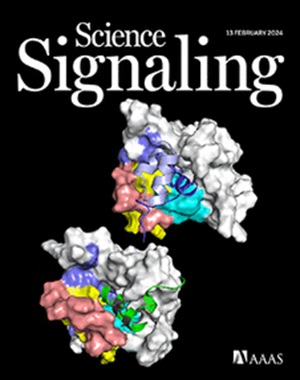Structural analysis reveals how tetrameric tyrosine-phosphorylated STAT1 is targeted by the rabies virus P-protein
IF 6.6
1区 生物学
Q1 BIOCHEMISTRY & MOLECULAR BIOLOGY
引用次数: 0
Abstract
Signal transducer and activator of transcription (STAT) family members mediate signaling in the Janus kinase (JAK)–STAT pathway and are activated by phosphorylation at a conserved tyrosine residue, resulting in dimerization through reciprocal interactions between the phosphotyrosine and a Src homology 2 (SH2) domain. Tyrosine-phosphorylated STAT (pY-STAT) then translocates to the nucleus to induce the expression of genes encoding antiviral proteins. Although the active and functional forms of STATs are conventionally considered to be dimers, STATs can undergo higher-order oligomerization, which is implicated in regulating transcriptional activity. We present the cryo–electron microscopy (cryo-EM) structure of the tetrameric form of intact pY-STAT1 in complex with DNA, which indicates that interactions between the amino-terminal domains (NTDs) of STAT1 induce oligomerization. The tetrameric structure revealed a compact conformation with a previously uncharacterized binding interface: Two DNA-bound dimers are twofold symmetrically aligned to transform into a tandem DNA-binding model without NTD dimer separation. Moreover, biochemical analyses indicated that the rabies virus P-protein selectively targeted tetrameric pY-STAT1. Combined with data showing which regions contribute to the interaction between pY-STAT1 and the P-protein, we constructed a binding model explaining how P recognizes the pY-STAT1 tetramer. These data provide insight into how pathogenic viruses target signaling pathways that mediate the host immune response.
结构分析揭示了四聚酪氨酸磷酸化的STAT1是如何被狂犬病病毒p蛋白靶向的
信号换能器和转录激活器(STAT)家族成员介导Janus激酶(JAK) -STAT通路的信号传导,并通过保守酪氨酸残基的磷酸化激活,通过磷酸化酪氨酸和Src同源2 (SH2)结构域之间的相互作用导致二聚化。酪氨酸磷酸化STAT (pY-STAT)随后易位到细胞核,诱导编码抗病毒蛋白的基因表达。虽然活性和功能形式的STATs通常被认为是二聚体,但STATs可以经历高阶寡聚化,这与调节转录活性有关。我们展示了完整的pY-STAT1与DNA复合物的四聚体形式的冷冻电镜(cryo-EM)结构,这表明STAT1的氨基末端结构域(NTDs)之间的相互作用诱导了寡聚化。四聚体结构显示出紧凑的构象,具有先前未表征的结合界面:两个dna结合的二聚体双对称排列,转化为串联dna结合模型,没有NTD二聚体分离。此外,生化分析表明狂犬病毒p蛋白选择性靶向四聚体pY-STAT1。结合显示pY-STAT1与P蛋白相互作用的区域的数据,我们构建了一个结合模型,解释P如何识别pY-STAT1四聚体。这些数据为了解致病性病毒如何靶向介导宿主免疫反应的信号通路提供了见解。
本文章由计算机程序翻译,如有差异,请以英文原文为准。
求助全文
约1分钟内获得全文
求助全文
来源期刊

Science Signaling
BIOCHEMISTRY & MOLECULAR BIOLOGY-CELL BIOLOGY
CiteScore
9.50
自引率
0.00%
发文量
148
审稿时长
3-8 weeks
期刊介绍:
"Science Signaling" is a reputable, peer-reviewed journal dedicated to the exploration of cell communication mechanisms, offering a comprehensive view of the intricate processes that govern cellular regulation. This journal, published weekly online by the American Association for the Advancement of Science (AAAS), is a go-to resource for the latest research in cell signaling and its various facets.
The journal's scope encompasses a broad range of topics, including the study of signaling networks, synthetic biology, systems biology, and the application of these findings in drug discovery. It also delves into the computational and modeling aspects of regulatory pathways, providing insights into how cells communicate and respond to their environment.
In addition to publishing full-length articles that report on groundbreaking research, "Science Signaling" also features reviews that synthesize current knowledge in the field, focus articles that highlight specific areas of interest, and editor-written highlights that draw attention to particularly significant studies. This mix of content ensures that the journal serves as a valuable resource for both researchers and professionals looking to stay abreast of the latest advancements in cell communication science.
 求助内容:
求助内容: 应助结果提醒方式:
应助结果提醒方式:


